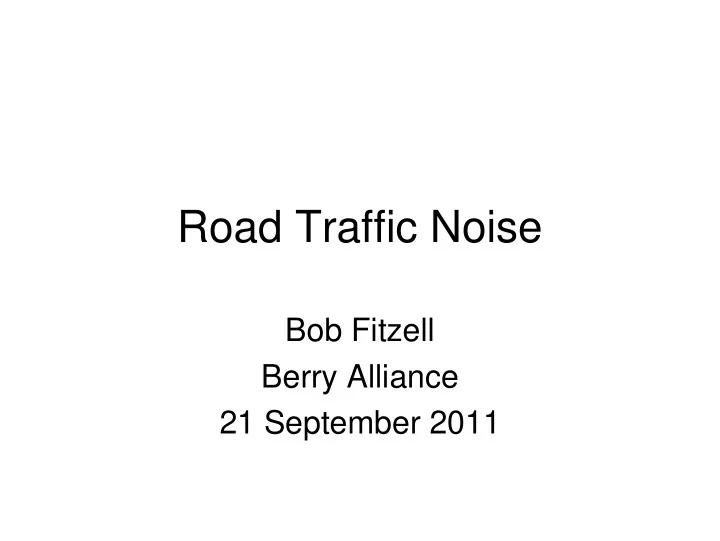

Road Traffic Noise Bob Fitzell Berry Alliance 21 September 2011
Basic Stuff • Noise is measured in decibels (dB) • Logarithmic measuring scale: 1 truck running – say 70dB 2 trucks running – 73dB 10 trucks running – 80dB BUT • Human hearing very non-linear, so truck revving at say 80dB sounds about twice as loud as truck running at 70dB, or something at 50dB sounds about twice as loud as 40dB(A).
More Basic Stuff • Noise propagates spherically – like a big expanding balloon. Mathematically, this means noise from a source reduces by 6dB every time distance is doubled. • A noise source that is, say, 20 metres away, sounds half as loud when it is moved to 60 metres away – i.e. distance needs to be multiplied by 3 for a sound to be about half as loud.
Typical Sound Levels
Basic Road Stuff • Acoustically, noise from a road is a combination of individual loud noises (e.g. trucks) and a somewhat continuous line of less discernible individual sources (e.g. a line of steadily moving cars) • Mathematically, noise from the individual sources attenuates at 6dB every doubled distance BUT noise from the line sources attenuates at 3dB every double distance
More Basic Road Stuff • So moving a road alignment from one distance to an alignment 3 times that distance away reduces loud noise events by ~10dB and therefore to about half as loud, BUT • You have to move a road alignment 10 times that distance before the steady background traffic noise reduces to about half
Important Road Stuff • At close distances from a road, loud noise events are the aspect that is most intrusive • At larger distances, the steady roar of vehicle noise tends to become the aspect that is most intrusive. • Loud events tend to relate to engine noise, particularly from trucks and motor bikes • A ‘quiet’ road surface reduces the steady roar noise, but not the loud events • Truck exhaust pipes are 3.2 to 3.6 metres high, so a barrier has to be higher still to be effective
Laborious Basic Stuff • dB(A) – attempt to approximate human sensitivity to frequency • Statistical measurements: L1 L10 Leq LA,eq,T
Laborious Basic Stuff
Vehicle Noise • Primarily, assessment criteria are based on LAeq • LA,eq,1hr=37.3+10log(M(1+.082p)) M is the number of vehicles per hour p is the % heavy vehicles Level is predicted for 25 metres • Trucks are roughly 10dB louder than cars • If night traffic is mostly trucks, traffic noise remains as loud even if passing vehicles drop to only 9% of daytime flow
Effects on Vehicle Noise • Reducing speed from 100kph: 90kph: -1.5dB(A) 80kph: -3dB(A) 60kph: -7dB(A) • Trucks are as noisy at 20kph as at 80kph Quietest at about 40kph • Gradient of 3% increases Leq noise about 1dB(A). Higher gradients greatly increase risk of engine brake noise from heavy vehicles • Any sudden change of speed causes loud noise events, so exit and entry arrangements need care
DECCW Criteria • These are the criteria that RTA is required to adopt to assess mitigation treatments: LAeq noise level complying with the table below Plus consideration of sleep disturbance
M2 Data A nalysis of M2 Measurem ents by B ob in 2004 (110kph, m aybe 3000v/hr) 95 90 85 Sound Pressure Level, 80 LA max 75 LA 1 LA 10 70 Laeq 65 60 55 50 0 50 100 150 200 250 Distance from nearest kerb, m
WHO Research, 2011
So annoyance expectations? A nalysis of M2 data by B ob (2004, 110kph, m aybe 3000v/hr) 45 40 35 Highly Annoy 30 25 % 20 HO W 15 10 5 0 0 50 100 150 200 250 Distance from Kerb, m
Prediction if AADT 20000 and no barriers
Adding a 5m high noise barrier
The RTA Approach • Beaver away on road design • Assess noise vs DECCW criteria • Attempt to minimise the constraints: - buy properties, and/or - improve design alignment, and/or - adjust road height/depth - consider tunnels? • Calculate treatment requirements • Assess what is “feasible and reasonable” to implement • Adopt mitigation treatments: - road pavement treatments, and/or - roadside noise barriers, and/or - earth berms, and/or - architectural treatments to buildings
Key Problems to Address • Background noise monitoring was 2007, summer, probably insects, not reflective of most adversely affected locations. Still appears to be used for Gerringong. Must do more. • “Feasible and Reasonable” Treatments: - Feasible: technically possible - Reasonable: DECCW discusses aspects to be considered, however there are no criteria used to decide “reasonable”. • Reasonable means different things to different stakeholders - RTA, residents, etc • Architectural treatments are inappropriate in an area such as Berry – why move here to live in a closed air-conditioned house (mitigation for 48 of the 83 dwellings identified in the Gerringong upgrade have been decided as architectural treatments) • Outdoor amenity is a key asset to the Berry area. There is no objective measurement basis for “amenity”.
UK Design Manual for Roads and Bridges, 1994
Recommend
More recommend